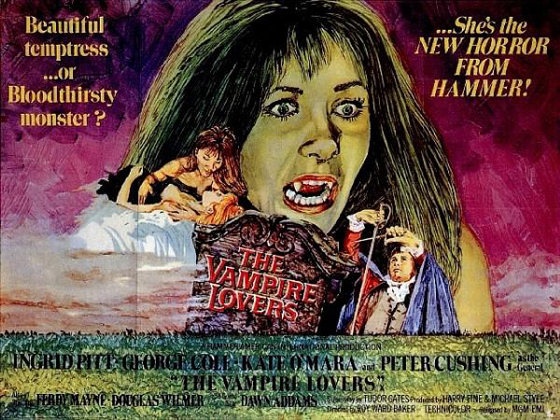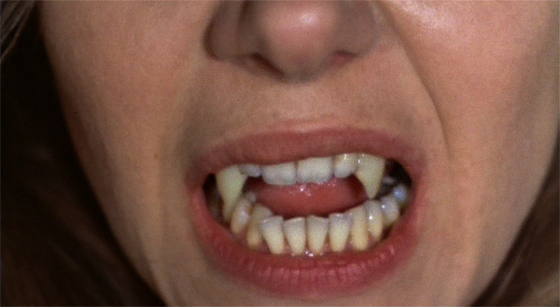
Since 1957’s The Curse of Frankenstein, Hammer Films became associated with pushing the envelope of sex and violence, and initiated a long series of skirmishes with the moralistic British Board of Film Classification that would last until the studio ceased production. During that span, the times changed, and attitudes loosened like the unlacing of a corset. The Vampire Lovers (1970) was a benchmark film for Hammer in its depiction of nudity and suggested sex, but peekaboo glimpses of female flesh had already begun creeping into its films; it was the immortal Carmilla, in the form of the voluptuous Ingrid Pitt, who at last flung wide the bedroom shutters. The film would initiate the somewhat informal “Karnstein Trilogy” (completed with 1971’s Lust for a Vampire and Twins of Evil), undoubtedly the sauciest material Hammer would ever unleash, but really a frantic attempt to keep up with the times, as British cinemas were already hot-and-bothered with films like School for Sex (1969), Zeta One (1969), Groupie Girl (1970), and The Wife Swappers (1970), to name just a few. Hammer had long been proudly displaying the décolletage of its nightgown-sporting vampire victims, but The Vampire Lovers advances the motif to some explicit breast-biting.
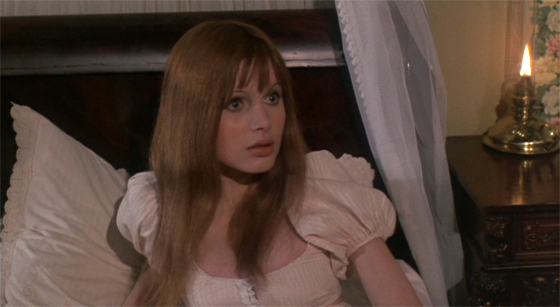
Madeline Smith as the innocent Emma.
Still, at least in this stage of the game, Hammer retained some attachment to its classy and literary productions of years past. What makes The Vampire Lovers so entertaining is that it presents an almost staid veneer – dress balls, manor houses, Peter Cushing – constantly interrupted by orgasmic bursts of flesh, gore, and lesbian overtures. The Bram Stoker/Sheridan Le Fanu contrast between civilized society and repressed lust had never been presented to such an extreme. Another adaptation of Le Fanu’s Carmilla, the film is more mercenary and direct than Roger Vadim’s poetic Blood and Roses (1960). The Polish-born Pitt plays the anagrammatic Marcilla, the daughter of a wealthy Countess (Dawn Addams), who has an eye for beautiful young women, and whose presence over a prolonged period of time leaves the girls empty husks. After draining one girl (Pippa Steele) dry, she moves on to the household of Roger Morton (George Cole) and lavishes her attentions on his virginal daughter Emma (Madeline Smith). Emma only knows that this woman – who has been introduced to her as “Carmilla” – has a worldly attitude that deeply impresses her, and she accepts her as her new best friend. Emma lets Carmilla dress her in a sexy, translucent dress. She lets her undress her. In bed, she lets Carmilla do something just below camera while Madeline Smith somehow makes her doe-eyes grow all the wider.
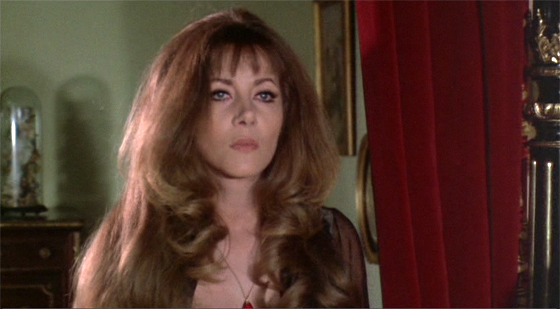
Ingrid Pitt as Marcilla/Carmilla.
Carmilla’s affections toward Emma seem to arouse some jealousy in the Governess of the house (Kata O’Mara of The Horror of Frankenstein). Not to worry – Carmilla is soon dividing her attentions, and drawing the Governess into her spell. As the increasingly bedridden Emma begins to grow pale and sickly, the butler Renton (Harvey Hall, who appears in all three Karnstein films in different roles) calls for a doctor against the commands of the Governess. The doctor – played, ironically, by Ferdy Mayne, the Count from The Fearless Vampire Killers – recognizes the signs of vampirism and places an order for garlic. In the battle for the soul of Emma, the tide seems to be turning, at least until Renton succumbs to the sexual advances of Carmilla. Finally, it’s up to General von Spielsdorf (Cushing), the Baron Hartog (Douglas Wilmer), and dashing young Carl (Jon Finch of Polanski’s Macbeth) to find Carmilla’s coffin and put an end to her scandalous ways. The final scene shows an ancient portrait of the ageless Carmilla Karnstein transforming into a decayed cadaver, in tribute to The Picture of Dorian Gray.
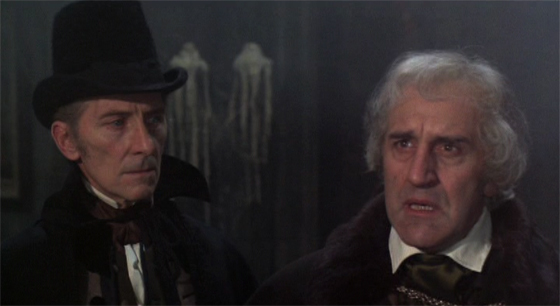
General von Spielsdorf (Peter Cushing) and Baron Hartog (Douglas Wilmer) race to destroy the vampire.
It’s almost beside the point that the plot is a muddle – there are far too many characters (I haven’t yet mentioned the mysterious vampire in black who commands Carmilla), and it all seems held together more by the audience’s familiarity with genre clichés rather than anything logical or coherent. What’s more important is the way the film integrates its lesbian theme into the comfortable vampire-movie framework. Lesbianism is so integral to the narrative that it is not even a subtext. We can see that Carmilla is sexually interested in Emma; we can see that Emma reciprocates the feeling, even though she doesn’t quite understand what she’s feeling. We can also see that Kate O’Mara’s Governess desires Carmilla even before the vampiress begins to control her actions. So this is really a film about proper society exterminating a plague of aberrant sexuality, and if that theme seems uncomfortable, the gleeful, exploitative angle taken by director Roy Ward Baker (Quatermass and the Pit) and writers Harry Fine, Tudor Gates, and Michael Style certainly wards off any seriousness. It’s easy to root for Carmilla, despite the fact that Cushing brings his usual gravitas to the vampire hunter role. Pitt, leading a cast of essential “Hammer Glamour” gals, is a wonder to behold, though she gives an even better performance in the more cohesive – but slightly less fun – Countess Dracula (1971). Smith is beautiful but a bit clumsy in her performance; she would fare better in her reunion with Cushing in Frankenstein and the Monster from Hell (1973). The Vampire Lovers kicked off a subgenre of lesbian-themed vampire films, among them Jess Franco’s Vampyros Lesbos (1971) with Soledad Miranda, and Jean Rollin’s unique Shiver of the Vampires (1971); but for Hammer – whose subsequent Karnstein films would be less interested in the lesbian angle – this profitable film would be a second wind, however short-lived, that would allow the company to issue more genre product for at least a little while longer. The new Shout! Factory Blu-Ray is a significant upgrade from the previous MGM “Midnite Movies” release (which was a flipper with Countess Dracula as the B-side), and features numerous extras, though the packaging and menu design places a bit too much emphasis on a misleading vintage poster design that disguises its Hammer origins: “Taste the deadly passion of the Blood-Nymphs! Caution: Not for the mentally immature!”
